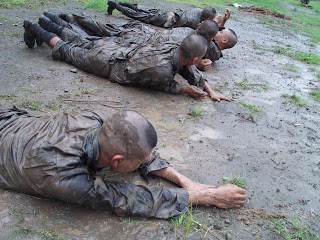
Squad Designated Marksmanship Training
“If all other else miss, we don’t”. We are the Squad Designated Marksman Class 01-09, trained and honed for the purpose of hitting our enemies at certain distance specified to us, and with a miss regarded as a mortal sin. For every bullet counts, every bullet driven from our barrels are bits of taxes laid by the Filipino people. Thus, we, as protectors of the people and state must not waste this support given and must suffice them of what they deserve. We can only satisfy them and extinguish their doubts through proper trainings and exercises, like the Squad Designated Marksmanship Training that was introduce in the Philippine Army in year 2004. During those old days, as we have heard and also confirmed, every rifleman were only trained to fire precisely at 25 
The SDM or Squad Designated Marksman supports the squad by laying down accurate rapid fire at distances beyond the normal engagement range of the Squad's Rifleman. The average Rifleman is trained to engage targets up to 300 meters away. A sniper engages targets beyond 600m while the SDM is trained to engage targets in "No Man's Land," the area between the capabilities of the two. Although the SDM receives much of the same training, he is not a sniper. The SDM is a rifleman and deploys as a member of a Squad. He maneuvers and engages with his Squad and never operates alone. To qualify to become a Squad Designated Marksman, you must score at least 36 or higher during Basic Rifle Marksmanship training. In the Philippine Army, the SDM must accurate and precisely shot a target with maximum distance of 300 meters, and still able to shot an average man-sized target up to 500 meters in order to support the Infantry, specifically, the squad. He is armed with a DMR or Designated Marksman Rifle. A DMR is an assault rifle with scope. On July 10, 2009, the 9th Division Training Unit had opened an SDM course with 21 enlisted personnel and 3 officers. These 21 enlisted personnel had emerged from different battalions of 9ID, PA which had taken first of somewhat we can call “entrance” examinations, which was expected to be so easy for them since they were supposed to be the best infantry Rifleman in the battalion. The 3 officers, newly-reported 2nd lieutenants, were taken from the newly graduated Platoon Leaders Course Class 09-01, and they were regarded as “Top Gun “of the class. When everything’s were set and students were able to receive their “reception rites”, it was the beginning of a new journey to excellence and perseverance in the road of marksmanship.

It all started with 24 naïve, regular infantrymen. Maj Harold Cabunoc, our course director, had adopted the holistic approach in the methodology of the course. First days were quite dehydrating and exhausting, with full of dry shoots and physical exercises in order to acclimatize the students in real-time scenarios of combat, with the role as a squad sniper. Basics of marksmanship were taught then harnessed after a while inculcated with frequent, sometimes forceful, repetitions of marksmanship drills. It went well, where as time rolls every individual is building his confidence and focus on the training, mediocrity fades. We also created an intimate relationship with our rifle, for every firing position, our rifle must be the extension of our body, and every tiny shock created due to imprudence and carelessness which will affect the sights will lead to an erroneous shot absolutely. Because an SDM receives much of a training of a sniper, the principles used in the training were sniper’s: marksmanship, fieldcraft and tactics. For marksmanship, every student was forged to meet the level of a sharpshooter. This was done through relentless execution of dry shoots, “coin in the barrel” firing, recoil simulation, up to ball and dummy firing then evaluation through live and recorded firing. When satisfying level was reached, we have come to moving targets. So, students had engaged moving targets at ranges 50, 100 to 200 meters, adopting different techniques. Since we will be dealing with scopes, then, we also had studied elevation, windage, and parallax or power knob adjustments in relation to minute of angles, come-ups, area elevation and wind consideration. In order to satisfy the standard of an SDM, we had fired metal plates in ranges 100, 200 and 300 meters, and fired man-sized, figure 11 targets in distances up to 500 meters. For fieldcraft, we had studied the environment and terrain. Camouflaging was then introduced. Were you able to hide? Were you able to blend? Were you able to deceive? If you answered yes to all these three questions, then you were able to camouflage. It is very important for an SDM to camouflage in order to employ security and execute mission with surprise. After then the SDM student were taught about map reading and land navigation. How will you fire if you can’t find the enemy nor reached the firing distance from your target? Series of drills were then done until they had mastered to navigate the possible “enemy’s land”. In lieu also of fieldcraft, we had studied distance estimation and effects of wind. Since in real-time scenarios, laser range finders, windspeed calculators and high-tech gadgets for angle depression calculation are not used because, basically, we can’t afford it; then, estimating distances, windspeed and angle depression with the help of some techniques and a functioning wit is what we had also mastered through practical live firing exercises. 
The SDM training had dramatically changed our lives. Most of the enlisted personnel had build confidence among them and carried a sense of pride for the knowledge they had acquired. Some of them had known their true limits. Others had discovered their hidden talents. All of us had realized that with small amount of cartridges we can still overrun and overwhelm our enemies. For no further operation can develop greater threat and psychological anxiety to the enemy but through long range operation like SDM operation. May, by our skill and valor, ceased the threats of CTMs in the Bicol Region for its peace and prosperity. Lay your confidence and trust to us, the SDMs, for we will gamble our status as best rifle shooters not only of Bicol but also of whole Philippine Army. It’s too late for the enemies to evade. We are already on our “natural point of aim” to miss their heads!



No comments:
Post a Comment